How To Draw People With Wings
This mail service has been originally commissioned for SketchBook Blog in 2016. Afterwards the site'due south migration, the original is no longer available, only you tin nevertheless admission the content hither. Bask!
Angels and demons, dragons and griffins, they all take 1 thing in mutual—they take wings and they can fly. Flying creatures are incredibly beautiful, simply they're as well quite hard to draw. How are wings synthetic? How exercise they work? How to describe all these feathers and the membrane? How to brand the fauna actually fly, and non merely flap its wings chaotically? In this tutorial I volition prove you it all, and you'll also have a chance to animate your character!
Y'all may also be interested in my newest tutorial about animating wings.
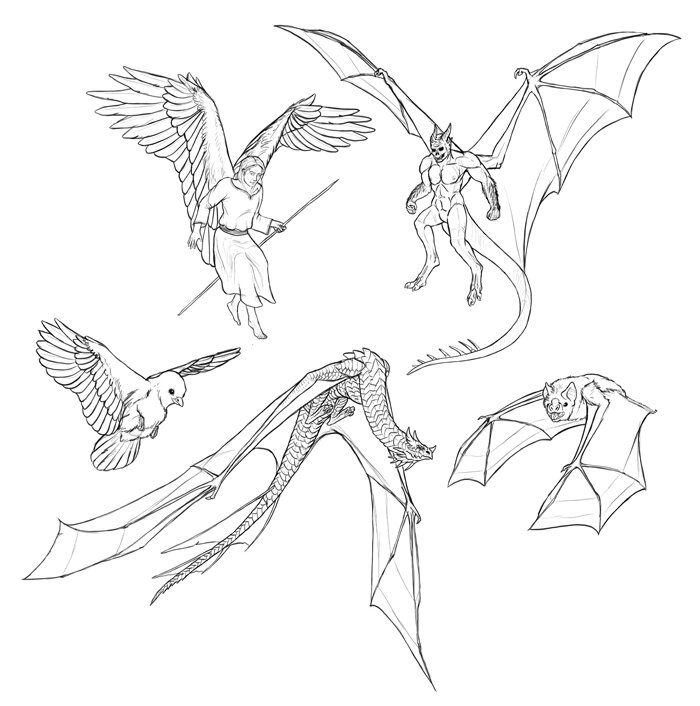
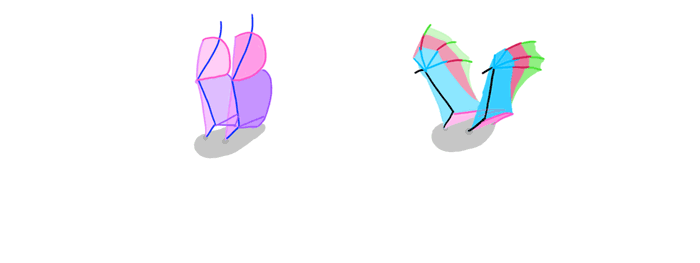
The Anatomy of a Bird Wing
Allow'southward starting time with a diagram you might have seen earlier—the comparison of bones in a homo arm and a bird wing. The similarities between them are very important to understand, because a wing is nothing else but a specialized arm with feathers sticking from it. They have the same joints, then you lot can simulate a move of a wing by moving your artillery.

Powerful chest muscles are required for an agile flight, and in birds these muscles are attached to a modified version of the sternum, chosen a keel. Why am I talking about it? Because wings are not merely "planes of feathers"—they're a whole structure growing from the trunk in a special, non-random manner. Keep it in mind when designing winged creatures.
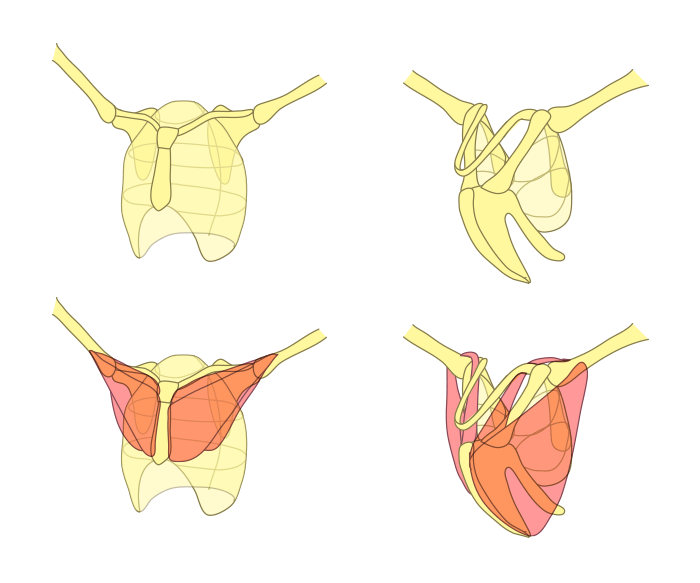
The feathers' design seem complex and hard to memorize, just once you understand the specific layers, you'll have no bug with it. So let's tackle them ane by one.
The primary feathers (likewise chosen primaries) are attached to the "hand". They're long and stiff, and some of them may be slotted—cutting for a better maneuverability. No matter how long the fly, at that place's usually ten of these feathers.
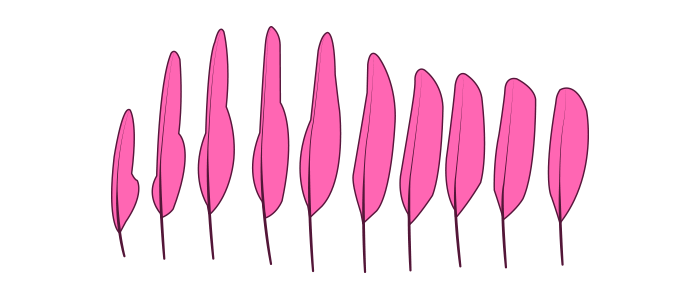

Primaries prevarication 1 upon each other, and this overlapping tin be seen when they're backlit—two layers of feather will be darker than i.
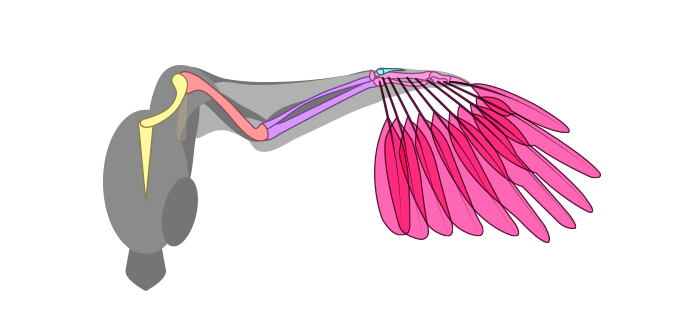
The "hand" bones are mostly merged, just they have some limited range of motion.
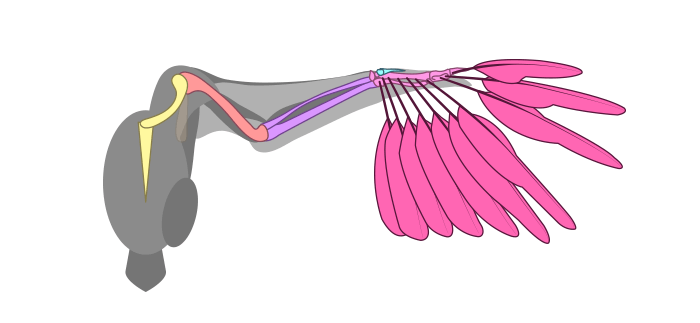
Let'southward have a wait at secondary feathers (secondaries) now. They're wider than primaries and they're never slotted. They seem to go to an reverse management as well, enveloping the elbow and turning towards the body at that point. The number of these feathers depend on the length of the fly.
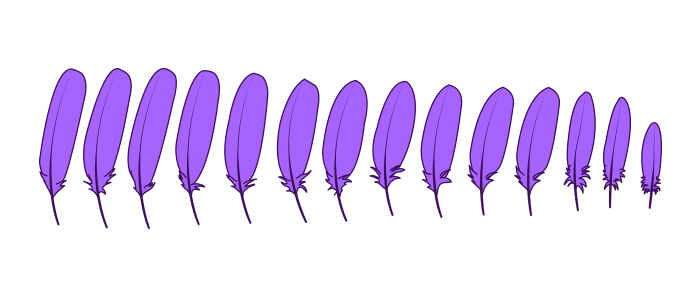
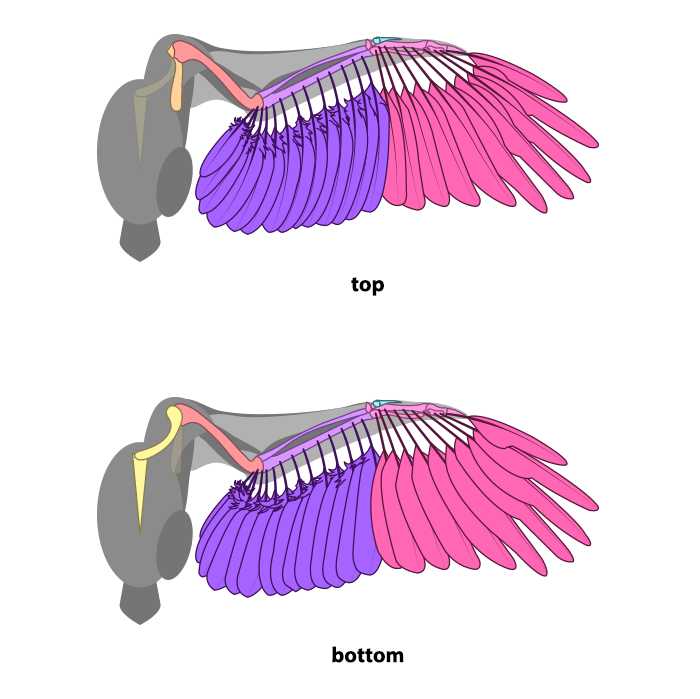
When wings are beingness folded, the feathers overlap each other following a rhythm of folding. When the bird keeps its wings close to the body, primaries are subconscious under secondaries.

Both primaries and secondaries are covered with greater coverts. They're like a smaller version of the feathers they cover. Each side of wing has its own layer of them, so this area will stay dark, even when the wing is backlit.

The "pollex" has its own cluster of feathers, chosen alula. It's visible on the top side only.
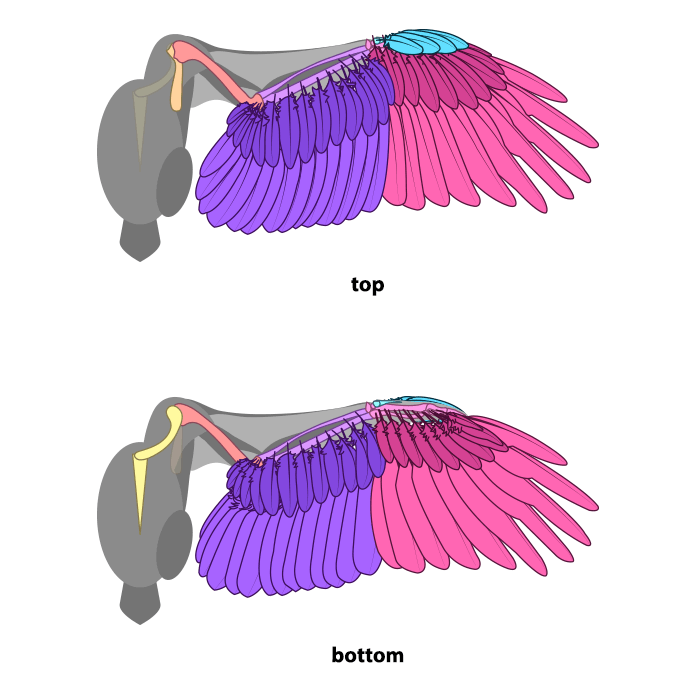
Just like a normal thumb, alula tin can move, though non very much. It can be helpful in some precise maneuvers.
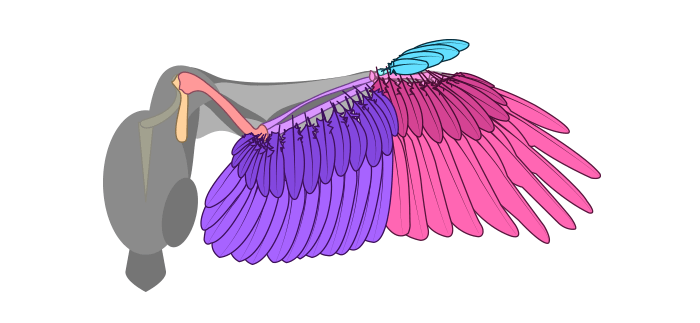
The shoulder and the wrist are connected with a tendon, and the whole area hither is covered with skin. A lot of tiny feathers are fastened to this skin: they're called lesser coverts. On summit of the fly median secondary coverts can also be found, but yous tin can make them a office of bottom coverts in your drawing.
On the underside of the wing these feathers are very soft and almost non-distinguishable. Y'all can sketch them chop-chop, leaving only a proffer of feathers.
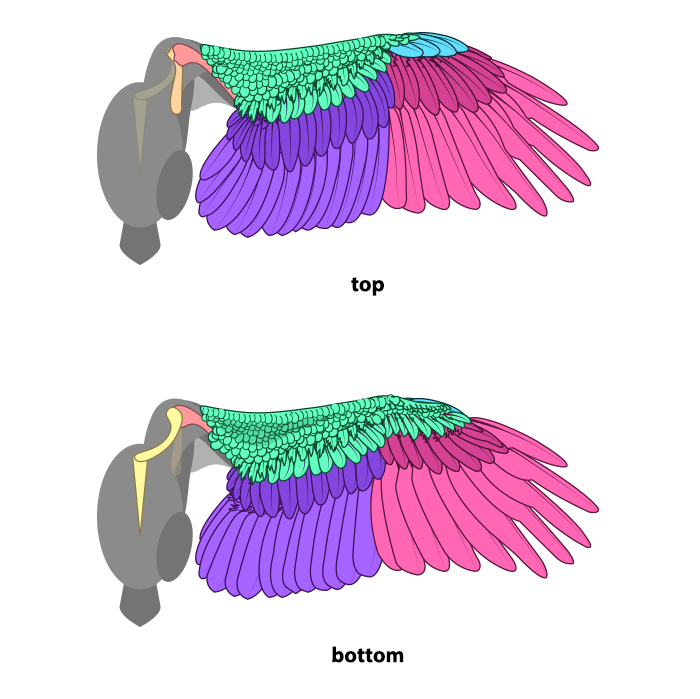
You can come across there'southward still some space between the wing and the body. It's filled with scapulars (feathers growing from the area of shoulder bract), the pall (a "greatcoat" of feathers covering the back), and, on the underside, the axillaries (likewise called tertials, only they're not truthful flight feathers. They grow from the armpit area).
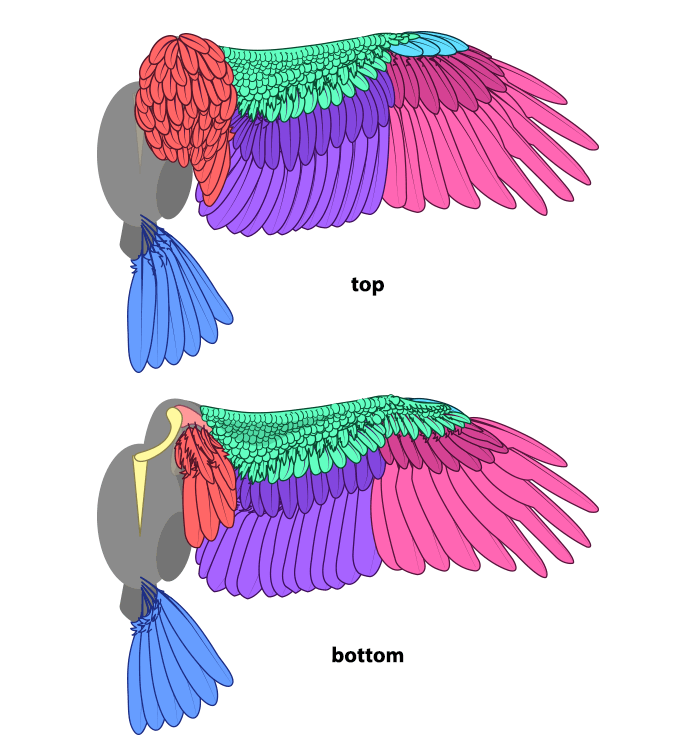
How to Draw Bird Wings Pace by Step
All this theory can be easily translated into a drawing. Start by sketching a line that will ascertain the front edge of the wing. This will let you lot create a basic pose for the wings without caring about the bones yet. Don't brand the hand surface area any longer than the level of chief coverts.
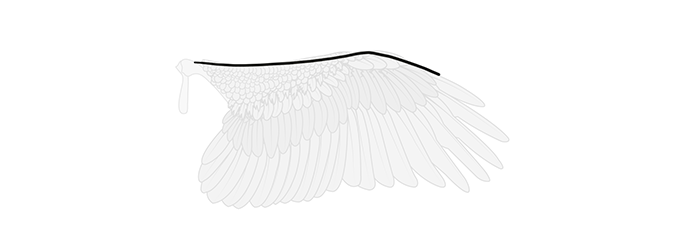
Now you lot can add the arm and the forearm. Anatomically, they should exist virtually equal in length, but usually a half of the arm is hidden in the torso, and so you lot can make it much shorter for simplicity's sake.
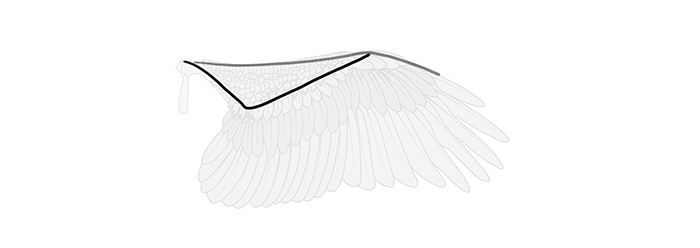
Now depict the longest primary feather. It's unremarkably somewhere in the eye.

Outline the border of the primaries, every bit if they got shorter when getting close to the tip of the finger.
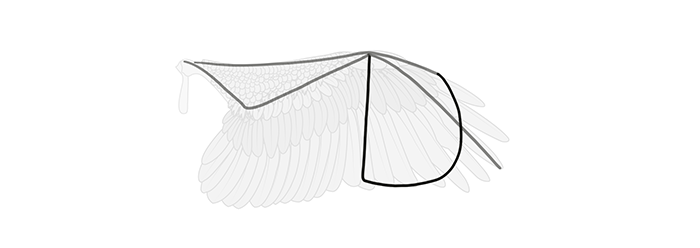
Draw the length of the secondaries at the elbow. Make it facing the body.
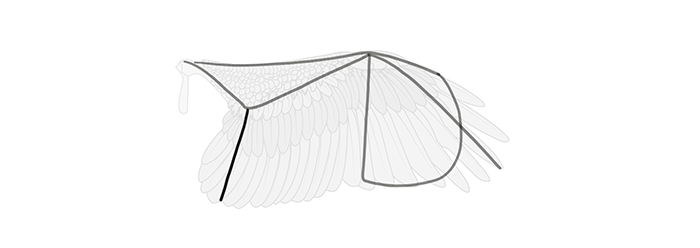
Outline the secondaries, along with this characteristic rounding near the body.

Time for the actual feathers. First the primaries…
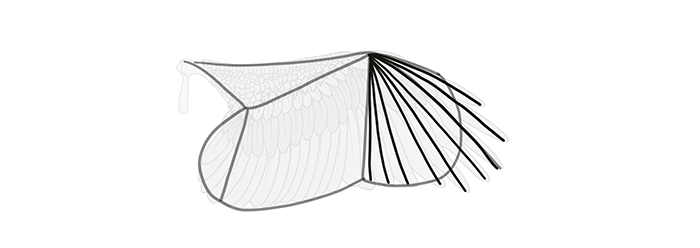
… and then the secondaries. Discover the characteristic rhythm!
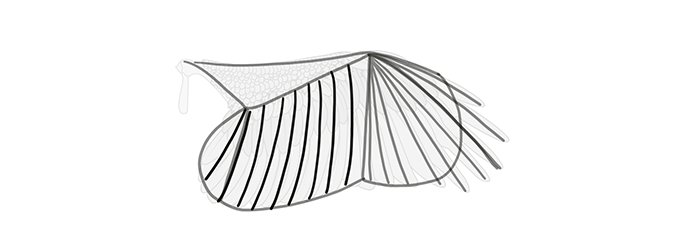
Finally, cover the feathers with the greater and lesser coverts, and add the alula.
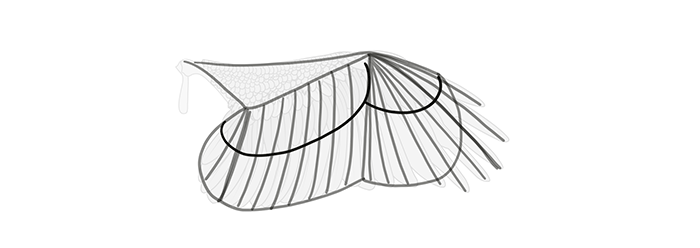
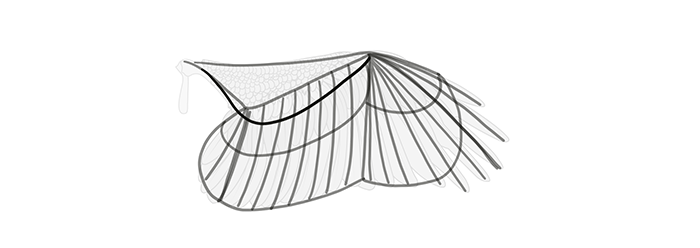
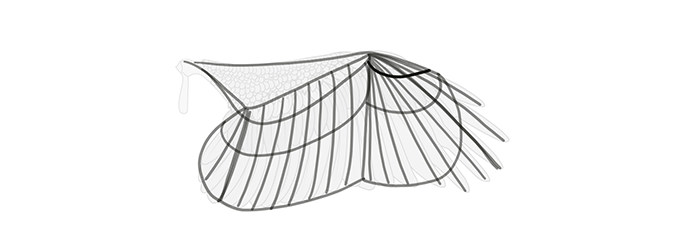
The fly is fully synthetic! Now y'all just need to draw the actual feathers on this base. It's proficient to beginning from the top:
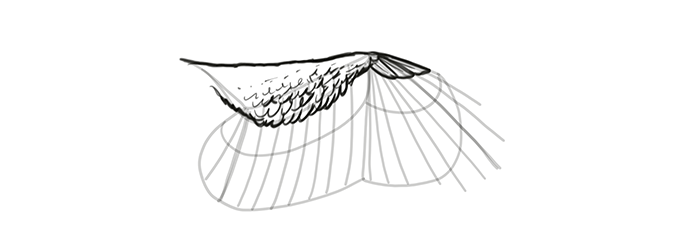
When you draw the row of feathers, keep in mind which side yous're drawing. First cartoon the closest to the trunk on the upperwing, and the uttermost from it on the underwing.
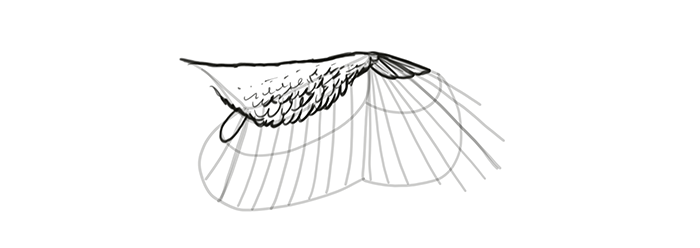
Don't make the feathers completely round. They should make dandy rows together.
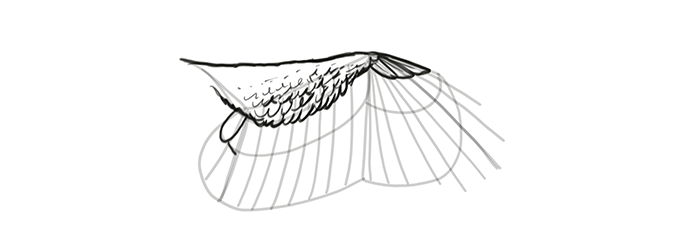
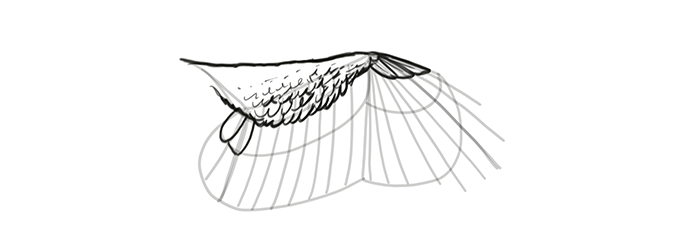

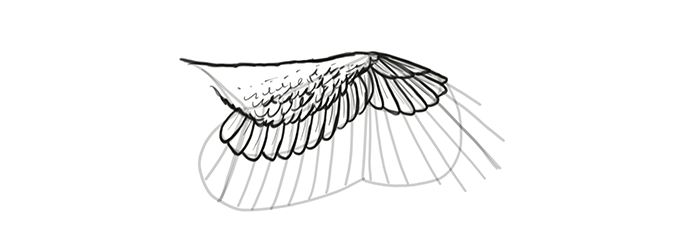
Secondaries can be drawn the same mode. Keep in mind they're big and overlapping, then if y'all desire to draw the rachis, don't place it in the middle of each feather.

Slotted feathers can exist fatigued by following the rhythm…

… and and so adding long, narrow tips to a part of the feathers.
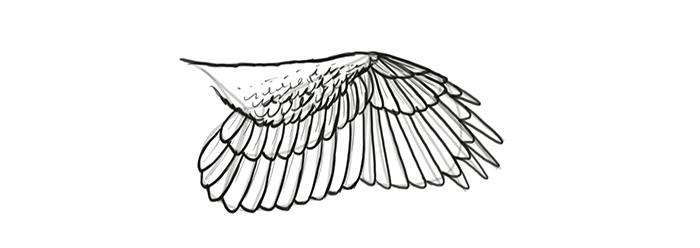
The fly is done!

Common Mistakes
Most mistakes in drawing come from trying to describe from memory something you don't quite remember (and not wanting to employ a reference). Stylization is ane matter, but if you were going for realism and failed, this is not style—information technology's a mistake. Let's meet what's incorrect with these wings.
- Zero anatomy—no arm, forearm and hand can exist found.
- The wing is simply glued to the body with one point.
- The feathers look like random scales—they seem to exist attached to each other/some surface beneath.
- The feathers are all sharply pointed.
- The surface can't push air efficiently—there'due south a hole betwixt the "primaries" and the body.

- There's some anatomy to the wing, simply at that place's no tendon between the shoulder and the wrist, creating a hole and making the wings less efficient at pushing air.
- The feathers don't overlap at all—air would become easily between them.
- It's not clear where the feathers abound from—there's no primaries or secondaries.
- The last feather is the longest, which would hurt the maneuverability.
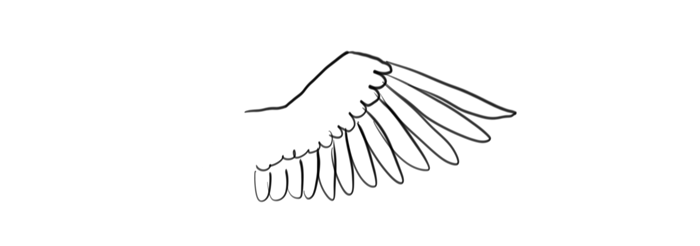
How to Breathing a Flight Bird and Depict Wings in Motility
The pose of wings is dictated by their function and the current action. If you want to draw wings in all poses from imagination, you need to empathise the whole procedure of flying and how wings make it possible. Looking at a photograph of a flying bird every bit a reference is only a temporary solution, and memorizing a few poses will limit your inventiveness also. The best mode to understand the rules of flight is to create your own animation, step by step, to run into exactly how the wing moves and changes shape in the procedure.
How to create your ain blitheness? You can utilize the FlipBook characteristic of SketchBook Pro. Here's a quick introduction. Go to File > New FlipBook > New Empty FlipBook. Cull a resolution, a depression frame charge per unit, and 11 for the Number of frames.
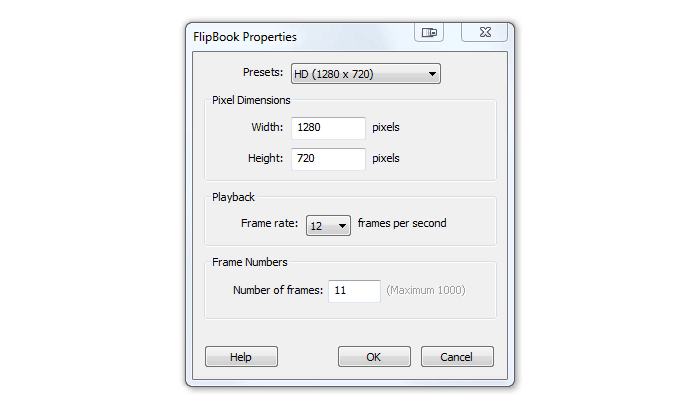
FlipBook is extremely simple and intuitive, then you may non even need this, but here's a quick explanation of the functions in case you're dislocated:
- Yous can adjust the start frame (i) and stop frame (2) of your animation, too as the overall number of frames (iii).
- You can add a new frame by clicking this push (4).
- You lot tin can meet a ghost of previous (5) and later (vi) frames to continue your blitheness smooth. You can also determine how many ghosts you want to run into by changing the numbers next to the buttons.
- You lot tin can play the animation by pressing this button (vii) or pressing Enter.

Let's animate the wings now! Since they move in three dimensions, I'm going to present iv views at in one case, so that you could see exactly what happens. Feel costless to choose any of them for your animation. You can employ your own arms equally a reference to visualize what I'm describing.
Flight is all most pushing the air down, so this is where we start. The wings are straightened and flat, gear up to begin the downstroke phase. All the feathers make a continuous surface without whatever gaps.
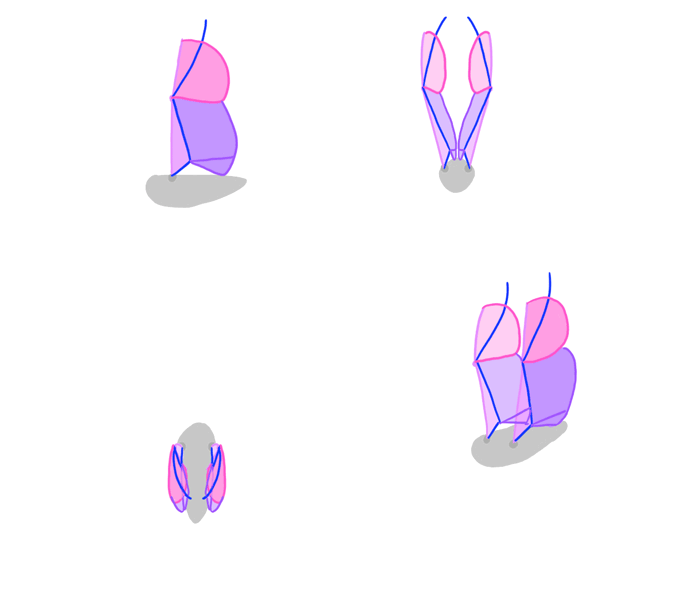
The wings are pushing the air down…

… lower and lower…
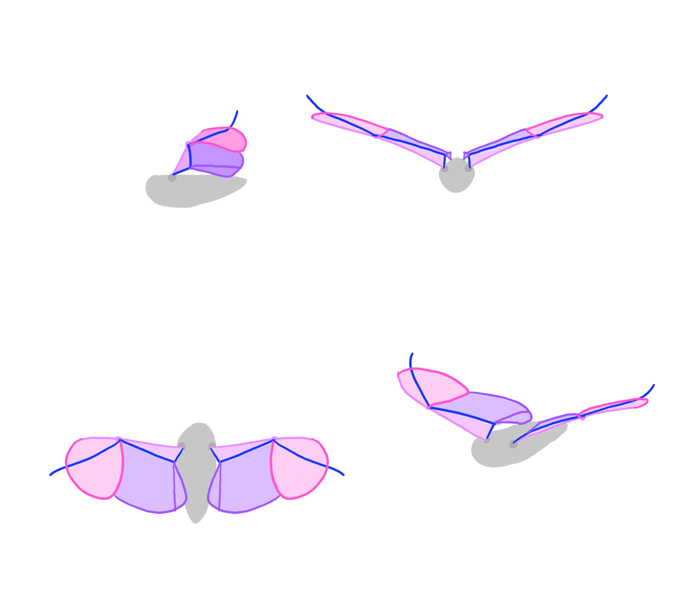
… until they get completely flat on the level of the body.
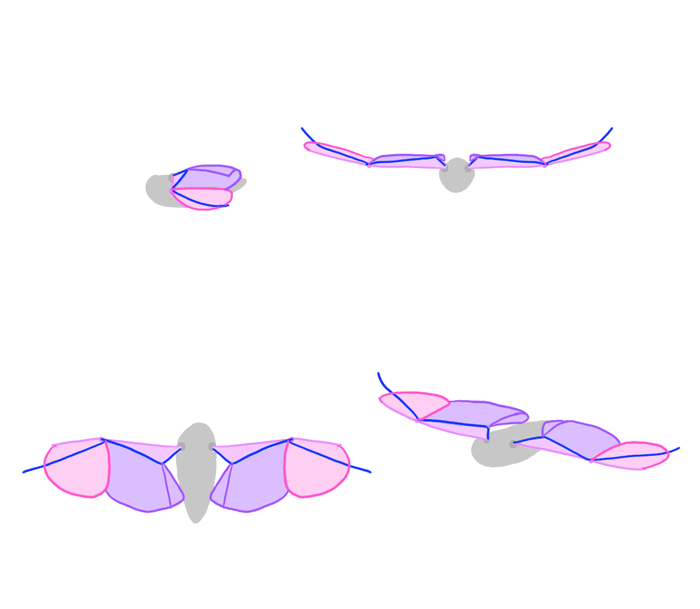
This was the easy office. Now the deep downstroke begins. The bird moves the wings downwardly… and forwards!

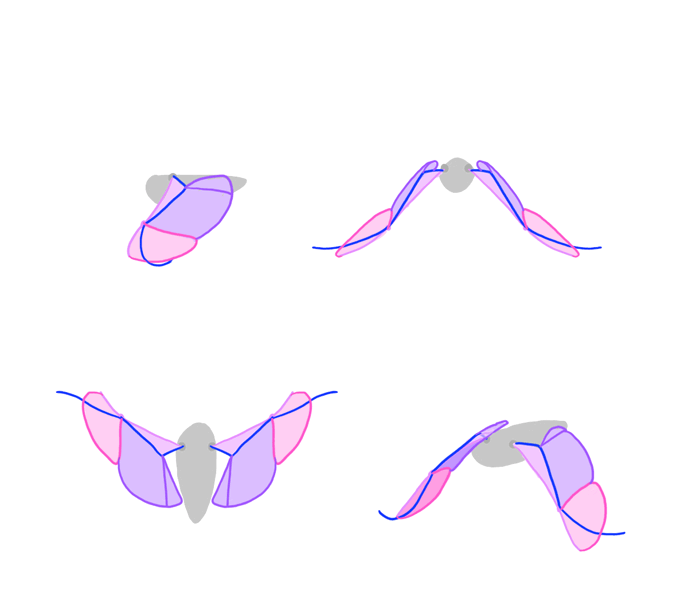
In the last step of downstroke the wings are straightened under the bird's torso.
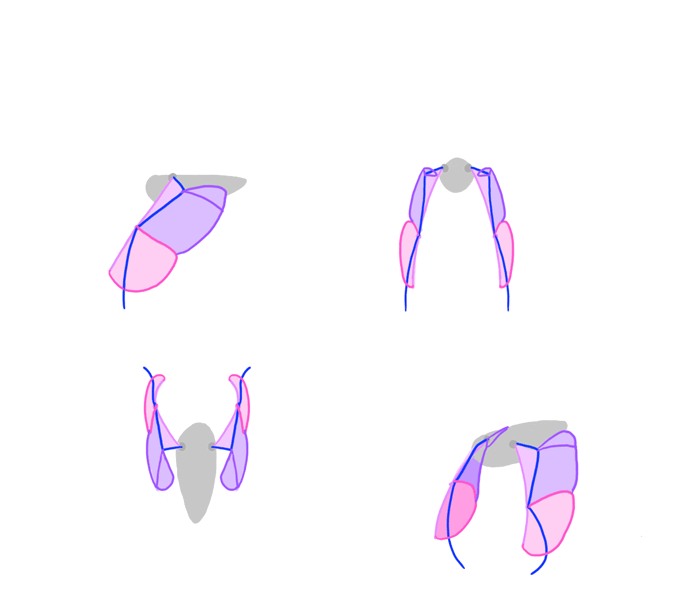
When there'south nothing more to push, the wings must be brought back upwards for another downstroke. This must be done fast, considering the bird is actually falling a niggling during the upstroke. That'due south why the bird is folding the wings on the way up, to reduce air resistance. This is the part where individual main feathers can be spread also—additional gaps help!
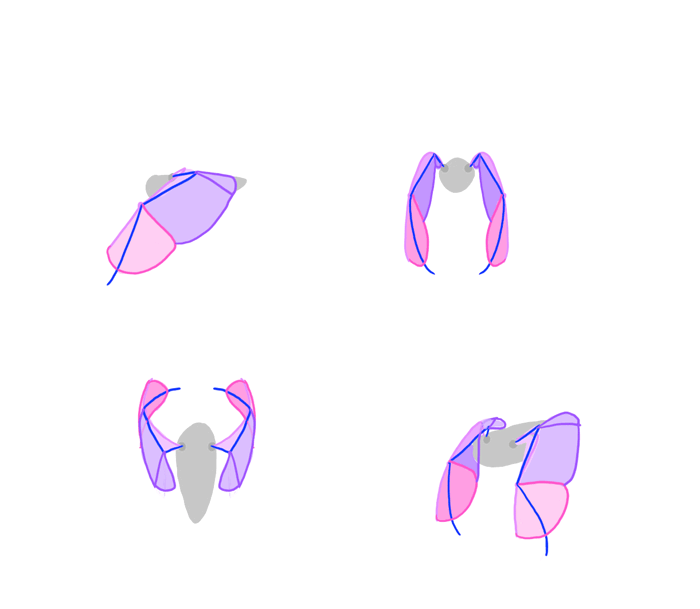
Notice how the wings are kept every bit close to the trunk equally possible.
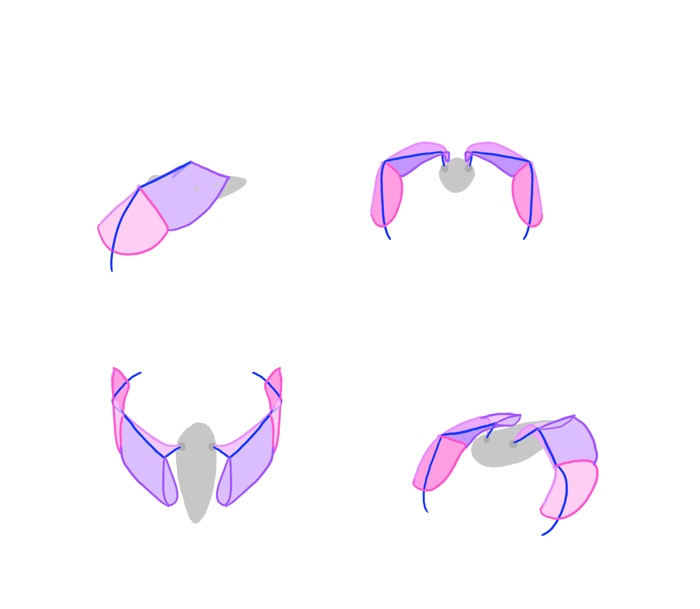
The wings are being unfolded office past part—starting time secondaries become to their straightened position, and then primaries.
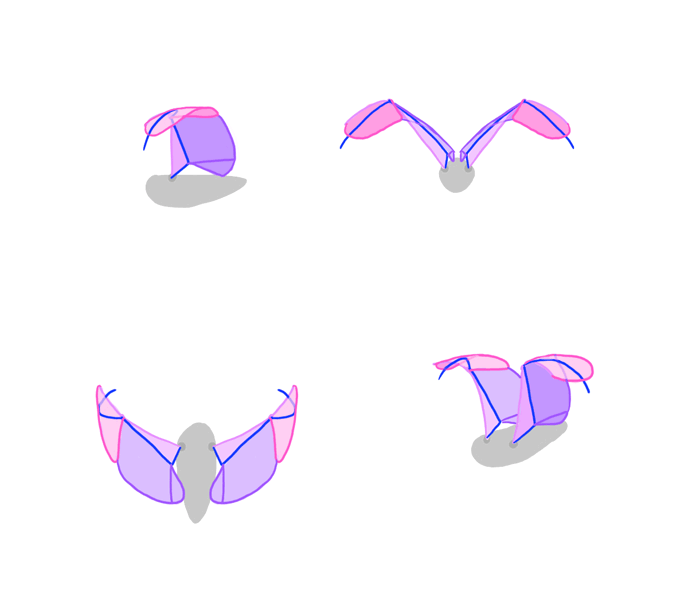
Finally, the primaries are straightened as well and the bird is set up for another downstroke!
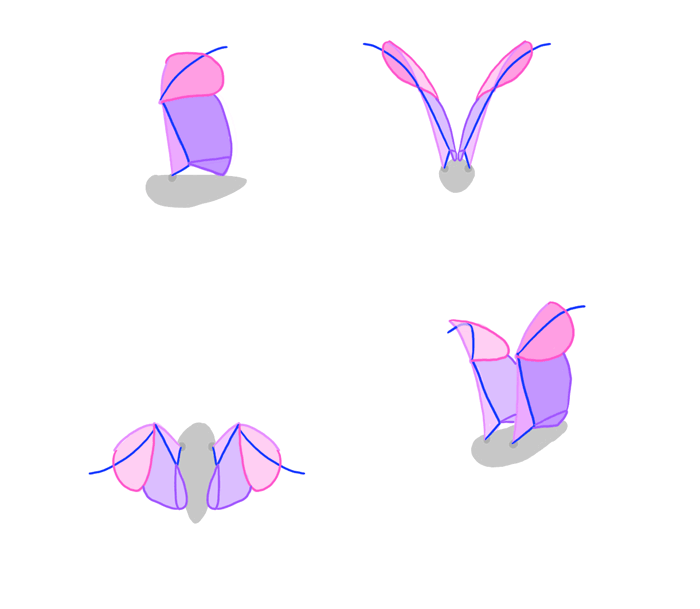
And here'due south a whole blitheness:
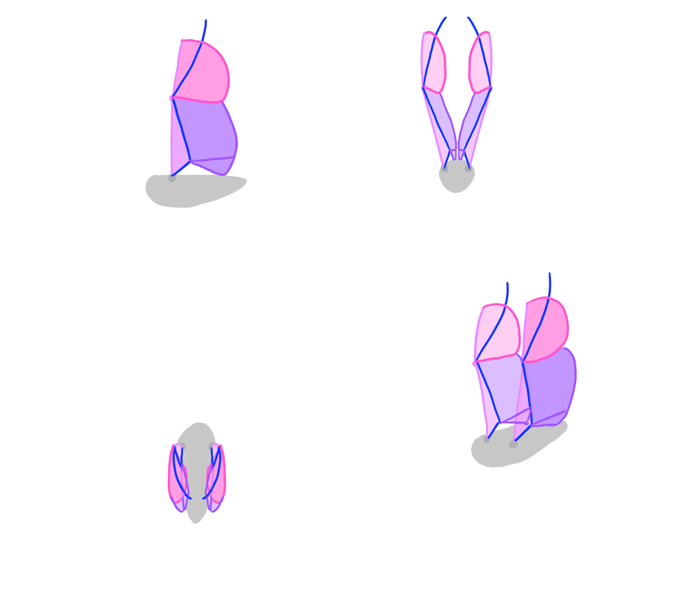
Every flight cycle doesn't look the same. Smaller wings will flap faster, with more extreme positions (deep downwards, far up, folded close to the trunk), but they volition also require less pushing forrard. Big wings button more than strongly forward, but they as well have less farthermost positions during the process.
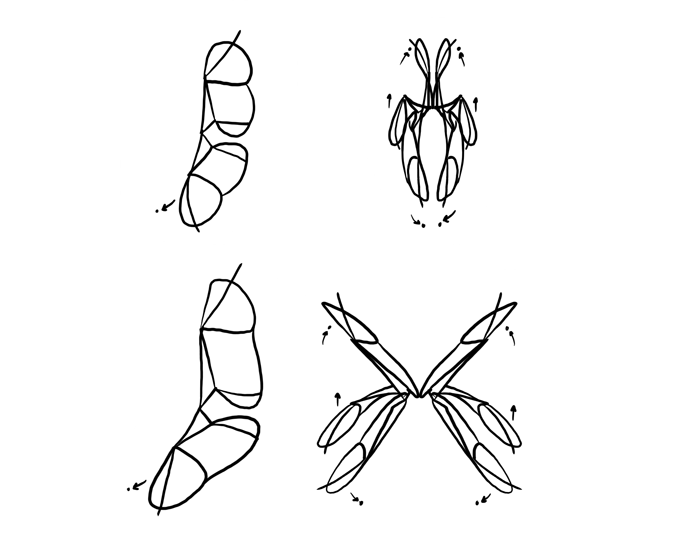
Now you know the theory behind the bird wings, but theory is non enough! Take your fourth dimension to test what you accept learned past drawing simplified wings from many different references. There are three exercises you lot tin try here:
- Create a montage of many references, lower their opacity, and draw on height of them.
- Look at a reference and try to describe the aforementioned pose using simplified wings.
- Look at a reference, hide it, and draw the pose from retentivity. And so check the reference over again to meet what yous got right and what wrong. Endeavour once again.
The Beefcake of a Bat Wing
Only birds aren't the only flying creatures on Earth. Let'south accept a expect at the only truly flying mammals: bats.
Because bats are mammals, they're more similar to humans than birds. Their wings are really elongated fingers with a membrane in between. The membrane is likewise connected to the hind limb, so that it can exist actively stretched.

The chest of a bat is also like to a human chest. Information technology'south simply much bigger in terms of proportion. In opposition to birds, bat can flap their wings by moving whole shoulders, non only arms (detect the clavicles and their potential range of motion).
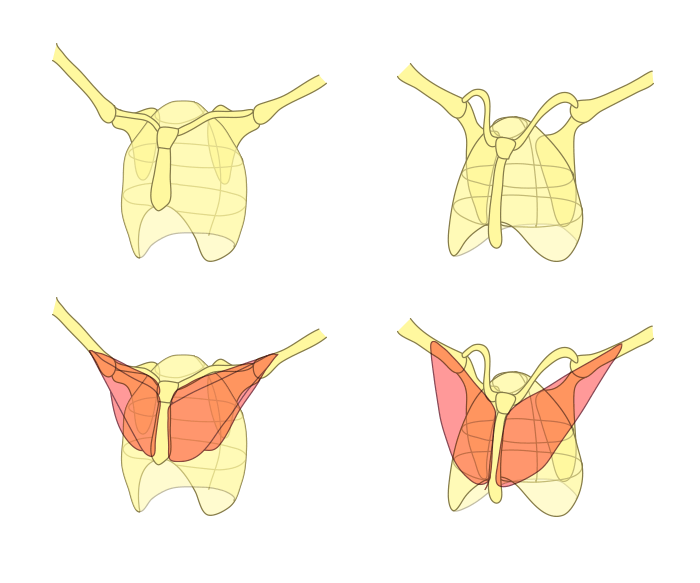
The membrane is one piece od pare, but for our purposes we can distinguish special areas of stretching. By drawing "stretching lines" in these areas you'll brand the wings look detailed very quickly.
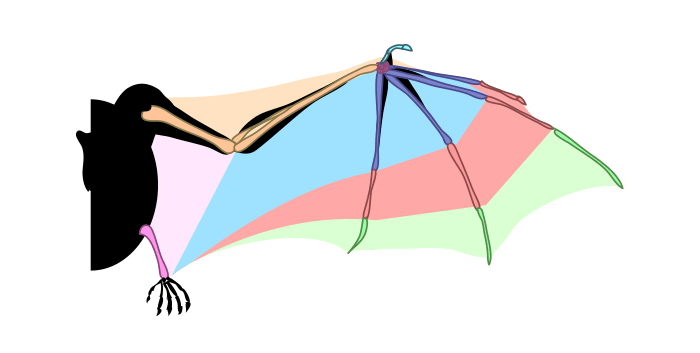
How to Draw Bat Wings Step by Step
Bat wings are pretty like shooting fish in a barrel to draw once yous know their structure. First with the edge of the fly and end information technology with a thumb. This will allow you define the general position of the wing.
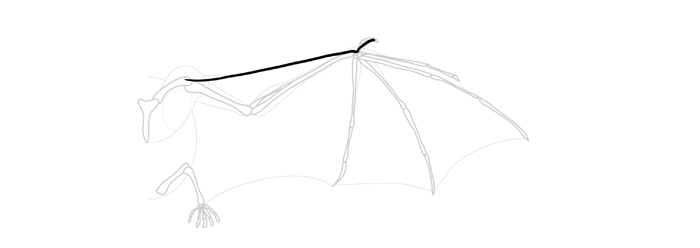
Create a long triangle to depict the whole arm.
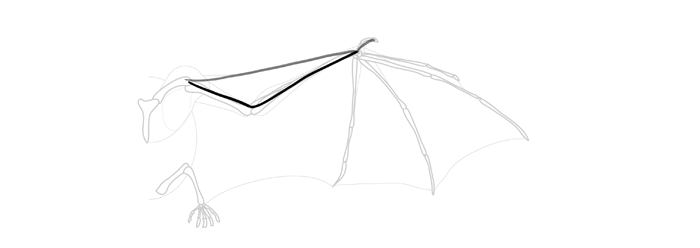
Now depict the fingers, part past part:
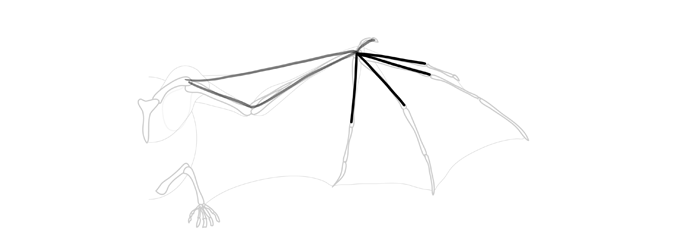
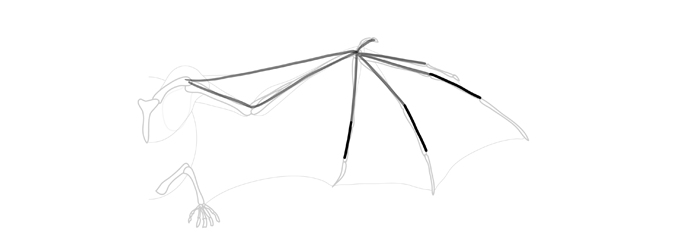
This part is the thinnest and the most flexible.
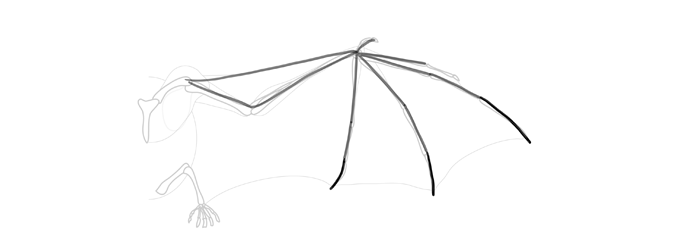
Don't forget to connect the membrane with the legs.
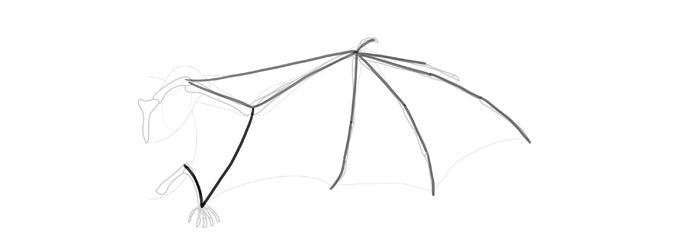
Finish the outline of the membrane. Notice the gentle arcs between the fingers.
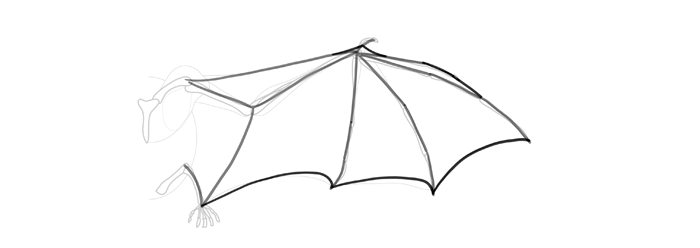
Finish the cartoon past adding the details.
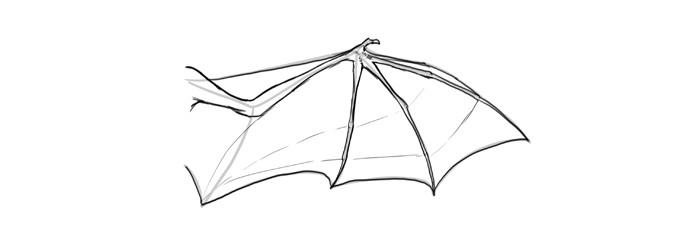
Common Mistakes
Many artists depict bleary wings incorrect, stating that if they're demon wings/dragon wings then nobody knows what they should look like. However, after this tutorial y'all should already know that wings are non just a decoration—they take a certain function and their shape reflects that role. Again, drawing decorative wings is not a mistake in itself, but if yous desire to depict realistically, here's what you must avoid:
- The wings is glued to the torso with one point.
- At that place'due south no arm, yet at that place are so many fingers!
- At that place's a pigsty between the wing surface and the trunk.
- The fingers accept no joints, so they can't bend (or they bend passively, like feathers).

- There'due south no membrane between the shoulder and the wrist—the wing is less efficient at pushing air.
- The arm is too heavily muscled, killing the air resistance.
- The membrane is deeply cut, which lowers its surface.
- At that place's a useless finger sticking out of the elbow, replacing the leg of a bat. If you want more than control over the base of the wing, a uncomplicated spike coming from the shoulder would exist a better thought.
- The fingers are thicker than necessary, making the wing needlessly heavy and rigid.

How to Animate a Flight Bat and Describe Wings in Motion
Bird or bat, their flying is all the same nearly pushing the air, and the whole process looks pretty similar. However, a bat's fingers are far more flexible than bird's feathers, so they take an active part in the procedure. Also, while birds flap with their whole artillery, bats flap with their fingers instead. Allow's take a closer look.
Bats flap their wings faster and more continuously and then birds (they're not too good at gliding), then wings are not brought also far over the back at the showtime of the downstroke—the flaps are shallow and quick. In this pace the fingers are outstretched to enlarge the expanse of the membrane.

So far and then good—no different than in birds.
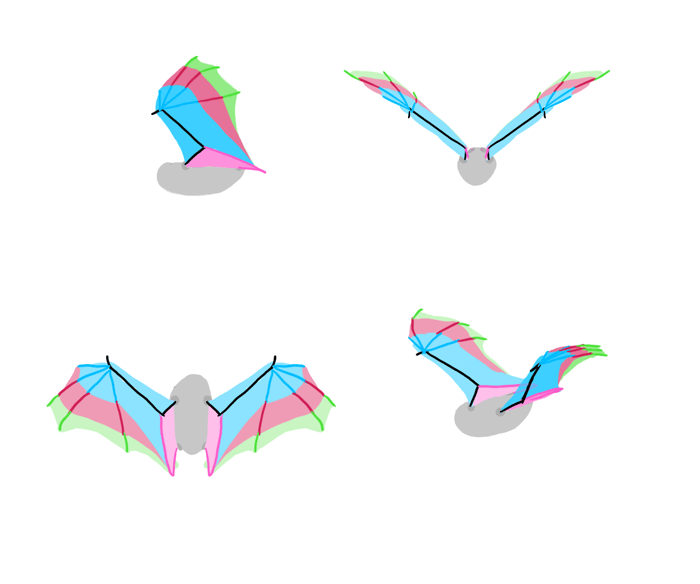
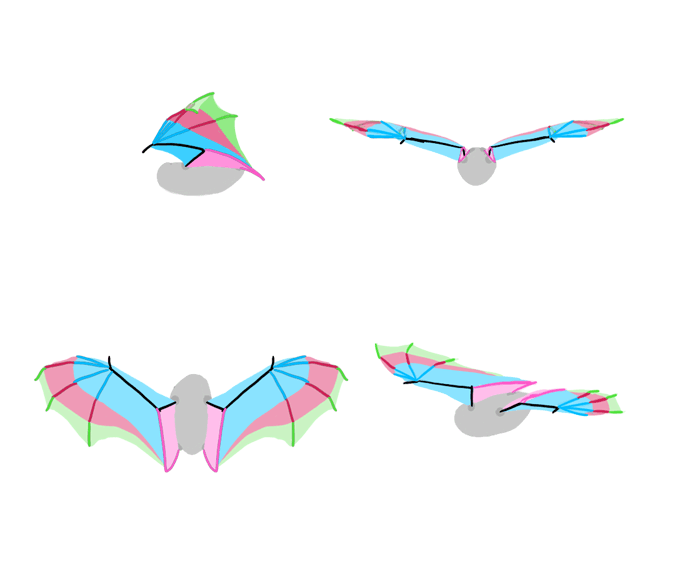
Find that the wings get frontwards much sooner!
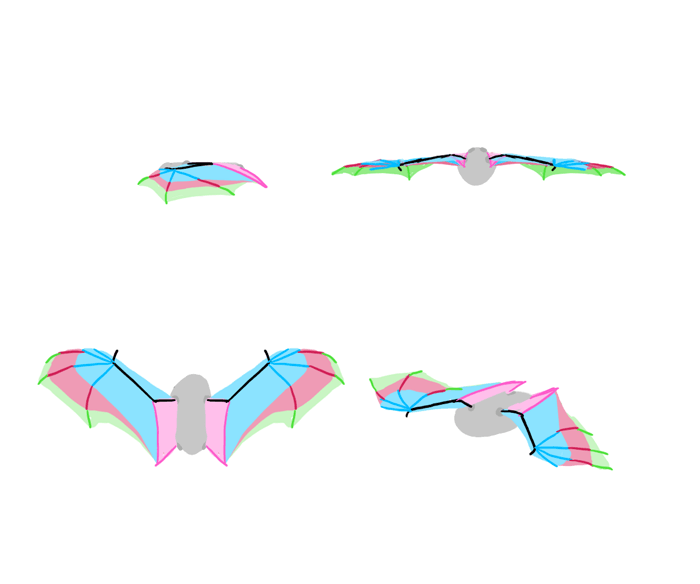
While the wings become downwards and forwards, the fingers rotate down as well, creating more lift—this is what birds cannot exercise with their immobile feathers! Too, notice how each phalange (finger bone) moves individually within its limits—that's why information technology's and then important to describe them separately and not as simple long lines bending like feathers.
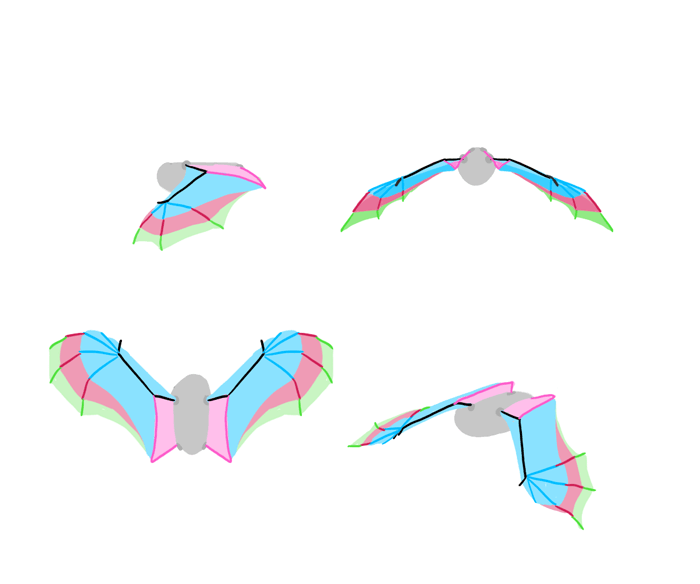
Here we have the end of the shallow downstroke—no need to button any farther, because the bat is able to generate some more than lift during the upstroke as well.

Time for the upstroke. Just like with the birds, the bat is folding its wings on the style up, merely in a more precise way—phalange after phalange. This way the upper part of the fly goes up, while the lower i keeps on pushing. For this to piece of work, the surface of the wing must be facing forward as long as possible.

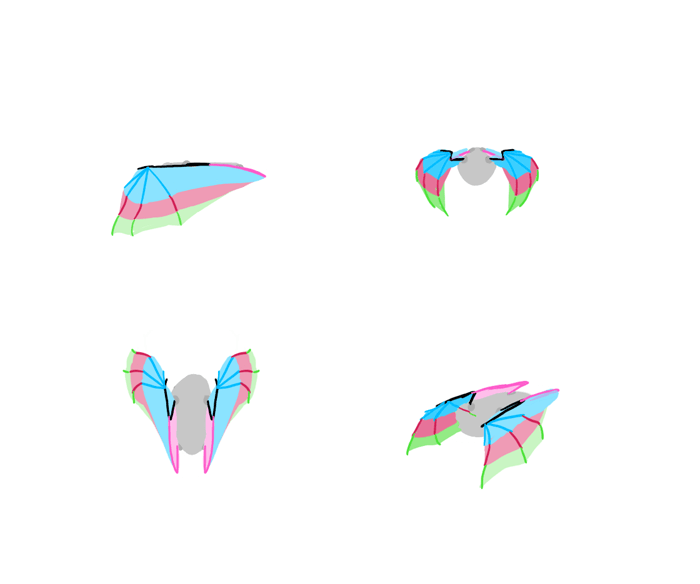
Notice how the tips of fingers keep pointing forward, fifty-fifty when the whole wing is going back.

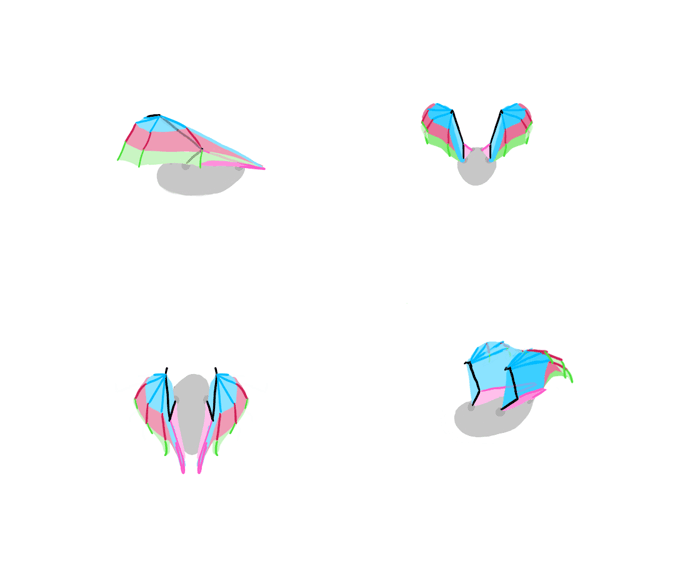
Finally, the whole wing gets straightened, phalange after phalange, from the base to the tips, to create a flat surface for another downstroke.
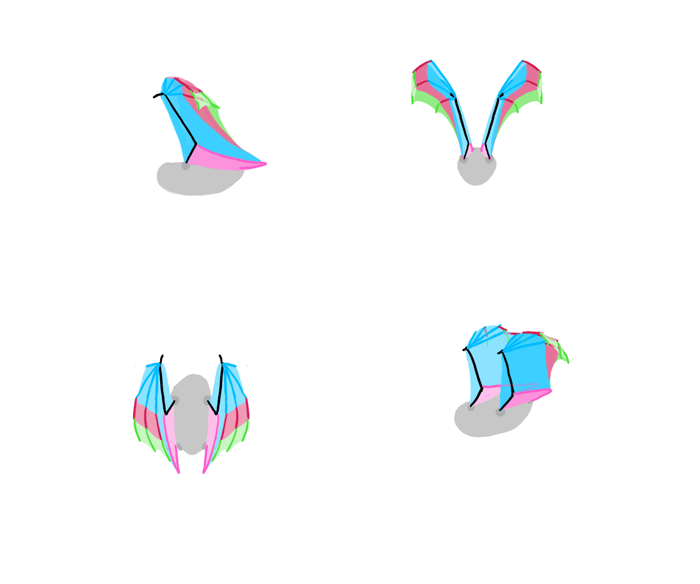
Here'south the whole animation. Tin can you see the divergence?
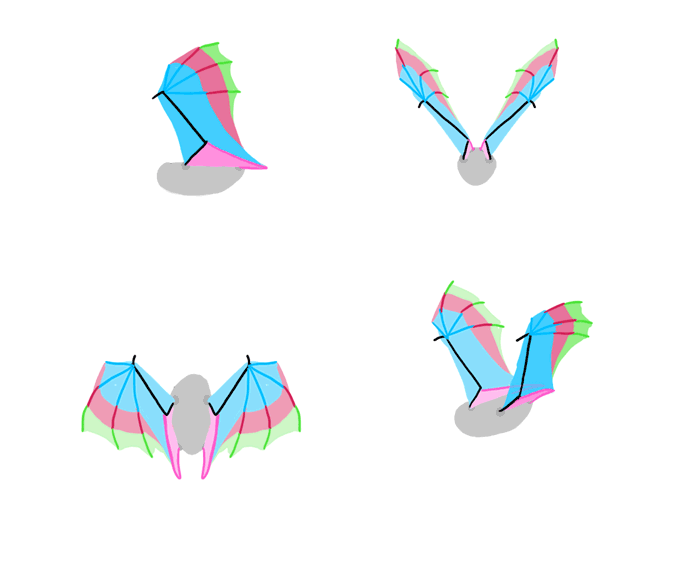
Once again, regular practice is needed to draw bat wings from imagination. Use the aforementioned exercises I described for birds.
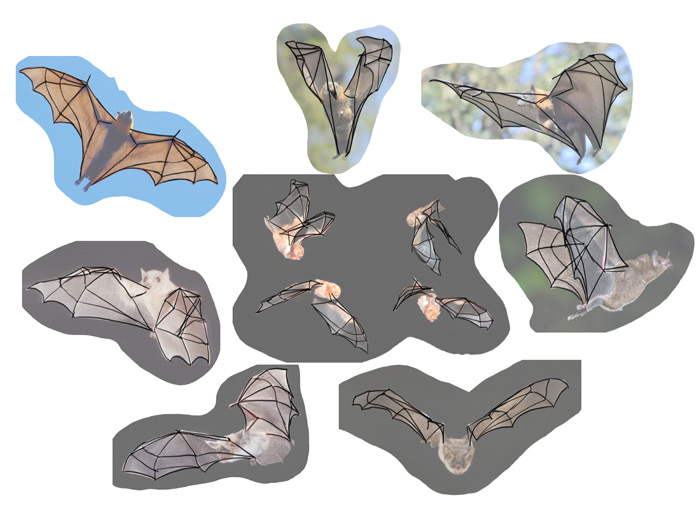
How to Describe Wings Step by Step
OK, that was theory. Only how to actually draw wings? Allow me show you how I do information technology, and experience free to create your ain method from what y'all learn.
Step 1
I've prepared the bodies of a few creatures that I want to add wings to: an affections, a demon, a bird, a dragon, and a bat. For the sake of this presentation they're finished drawings, simply ordinarily I would draw them along with the wings—this fashion I could change the pose of the trunk if the wings turned out to require it.
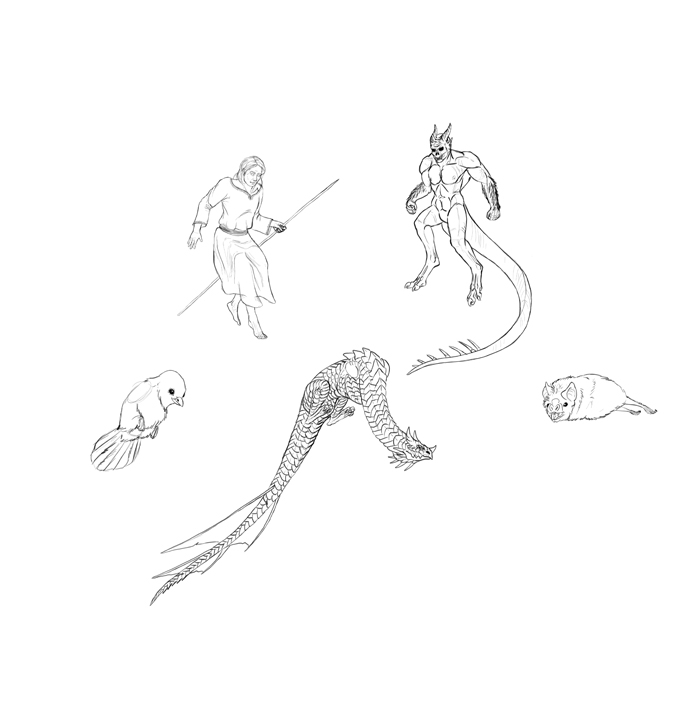
Pace 2
Start with a very general pose of the wings. First sketch a direction, and and so bend the wings according to the stage of flight they are in. As you know now, downstroke and upstroke are very different!
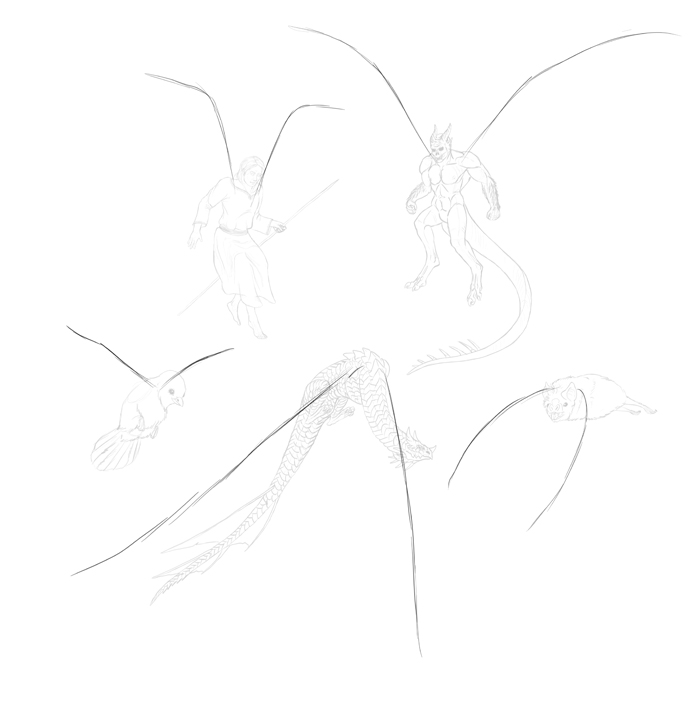
Step 3
Add the artillery. Brand certain you follow the perspective of the body.
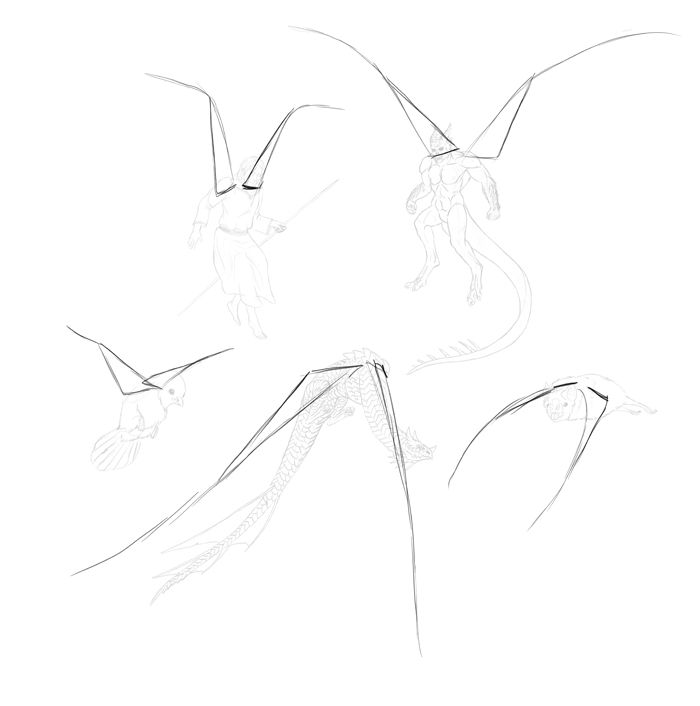
Step 4
Describe the long primaries (in example of feathered wings) and the fingers (in instance of membranous wings). Again, perspective is very important here. If yous're having problems with this footstep, it may mean you need to spend some more time practicing perspective.
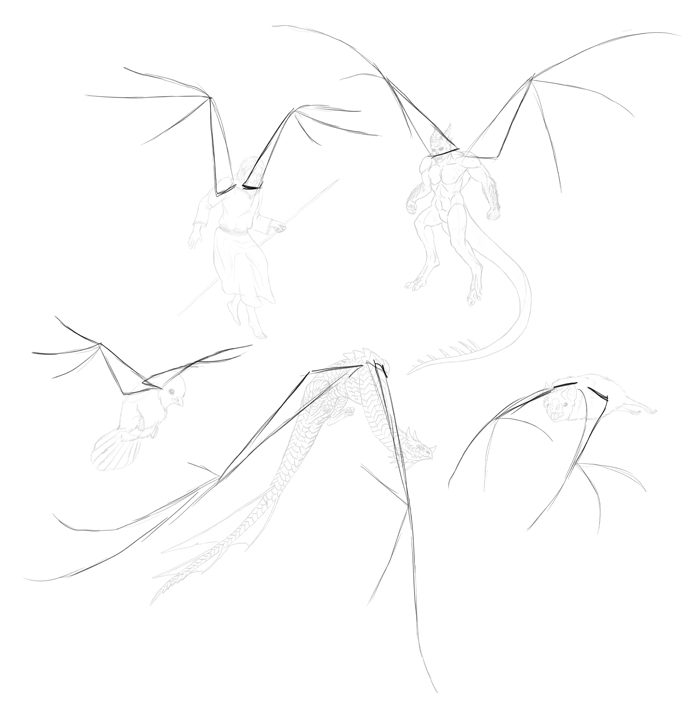
Step five
Depict a line from the elbow pointing towards the body. These lines really help with perspective.
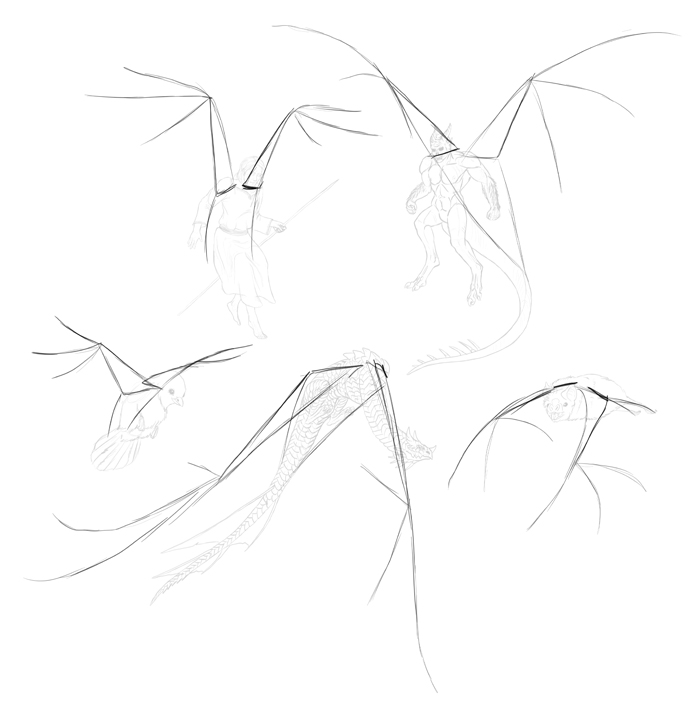
Pace vi
Depict the finger joints in the membranous wings, and the outline of primaries in the feathered wings.

Step 7
Add together the secondaries and the membrane.
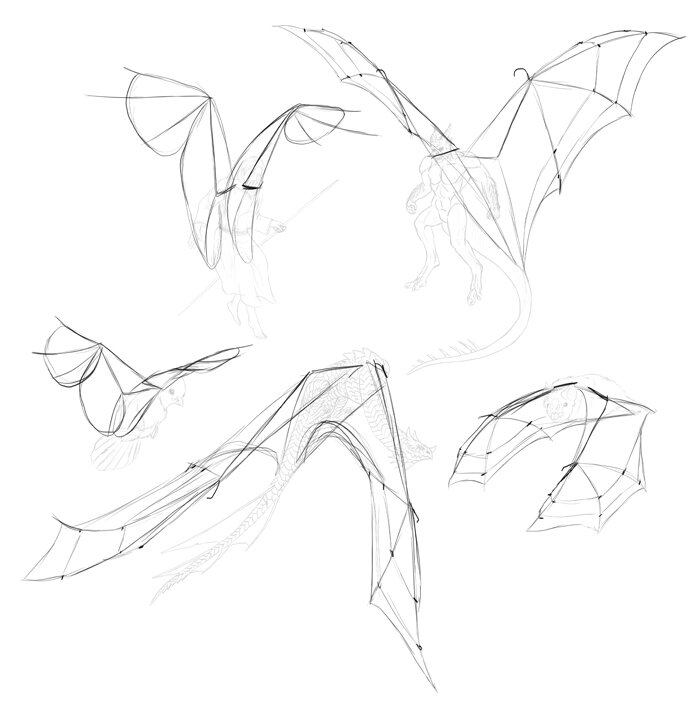
Pace eight
Sketch the direction of the feathers, and add some volume to the artillery in bleary wings.
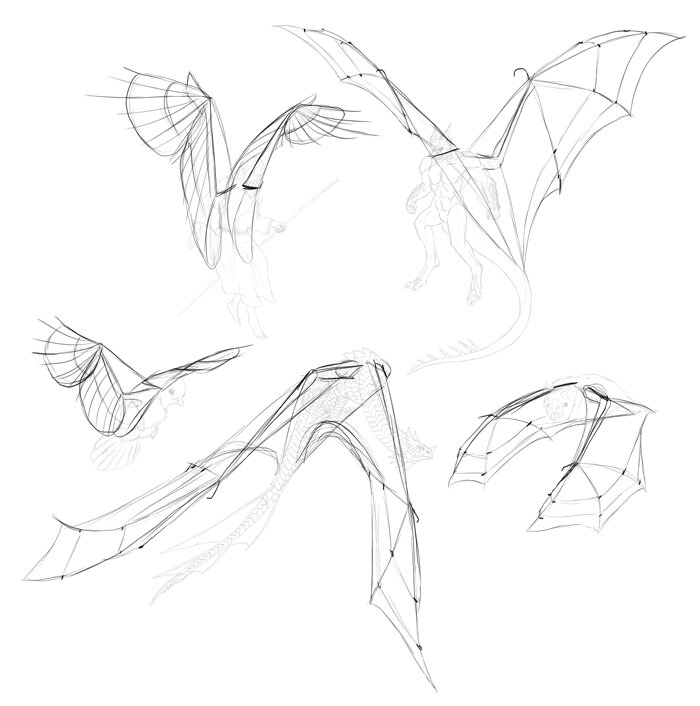
Pace 9
FInally, finish the drawing with all the details.

That'due south All!
I've shown you lot how bird and bat wings are constructed, and how to draw wings in flight. Only before y'all go straight to all your angels and dragons, accept your time to exercise drawing existent birds and existent bats—different sizes, different species, different poses. This is the only style to draw from imagination, without having to come dorsum here all the time for a reference. Though, I won't listen if you practise!
Source: https://monikazagrobelna.com/2019/08/23/sketchbook-original-how-to-draw-wings/
Posted by: gilmoretooffer55.blogspot.com

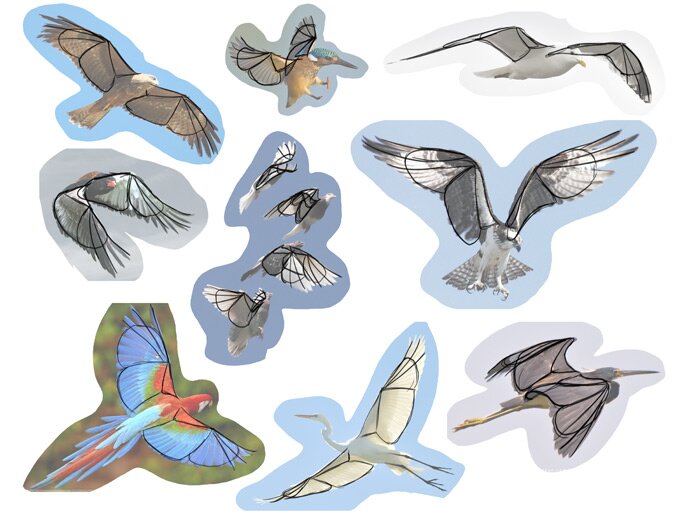

0 Response to "How To Draw People With Wings"
Post a Comment